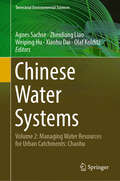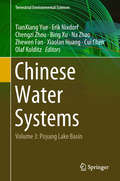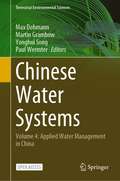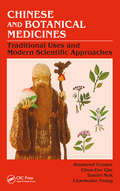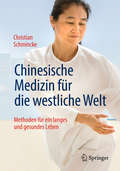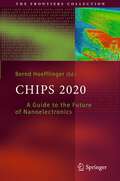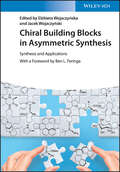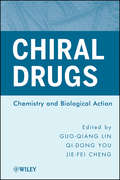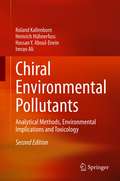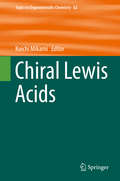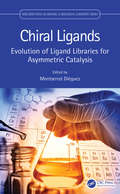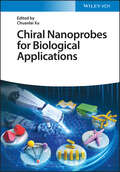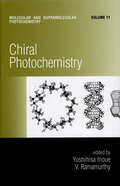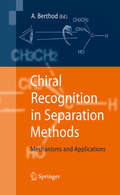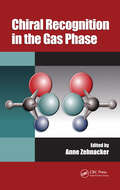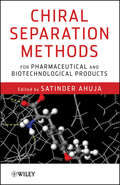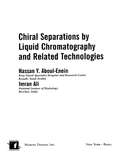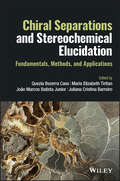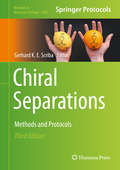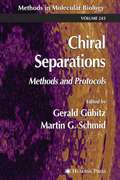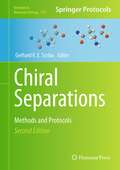- Table View
- List View
Chinese Water Systems: Volume 3: Poyang Lake Basin (Terrestrial Environmental Sciences Ser.)
by Weiping Hu Olaf Kolditz Agnes Sachse Zhenliang Liao Xiaohu DaiThis volume addresses the latest results of the Major Water Program of the Chinese Government which aims at the restoration of polluted water environments and sustainable management of water resources in China. It specifically summarizes the results of the BMBF-CLIENT project “Management of Water Resources in Urban Catchments” and the related MoST project “Key Technologies and Management Modes for the Water Environmental Rehabilitation of a Lake City from the Catchment Viewpoint” in Chaohu. The project is conducted by the Helmholtz-Centre for Environmental Research UFZ, Technische Universität Dresden, German and Chinese companies (WISUTEC, AMC, bbe Moldaenke, itwh, OpenGeoSys e.V., HC System and EWaters) in close cooperation with Tongji University, Nanjing Institute of Geography and Limnology of Academy of Sciences, Institute for Hydrobiology of the Chinese Academy of Sciences and the Chaohu Lake Management Authority. The book explains the development of concepts and solutions for sustained water quality improvement in Chaohu, combining urban water resource management, decentralized sanitation solutions, methods in water quality assurance, environmental information systems and groundwater modeling.
Chinese Water Systems: Volume 3: Poyang Lake Basin (Terrestrial Environmental Sciences)
by Olaf Kolditz Bing Xu Erik Nixdorf TianXiang Yue Chengzi Zhou Na Zhao Zhewen Fan Xiaolan Huang Cui ChenThis volume of the Chinese Water Systems subseries offers up-to-date and comprehensive information on various aspects of the Poyang Lake, the largest freshwater lake in China. Following a detailed introduction of the lake basin, the respective chapters present the findings of studies examining surface and subsurface hydrology, relationships between plant ecology and pollution of the wetlands, changes of land cover as well as the development of modern computational approaches to create Environmental Information Systems for water management. Moreover, the results are supplemented by a wealth of numerical calculations, tables, figures and photographs to make the research results more tangible. Closing with concise information on the “Research Centre for Environmental Information Science” (RCEIS), the book offers a valuable guide for researchers, teachers and professionals working in the areas of water environment, water security and ecological restoration. The projects have been supported by the Sino-German Centre for Science Promotion, the Helmholtz Association and the Chinese Academy of Sciences.
Chinese Water Systems: Volume 4: Applied Water Management in China (Terrestrial Environmental Sciences)
by Martin Grambow Yonghui Song Max Dohmann Paul WermterThis open-access book addresses latest Sino-German results of the joint research efforts within Major Water Program of the Chinese Government supported by German research funding. The Major Water Program aims at the restoration of polluted water environments and sustainable management of water resources in China. The joint BMBF-CLIENT project SINOWATER deals with three most significant and strongest polluted Chinese waters, the river Liao and the Dian-lake as well as Tai-lake in the area of the metropolises Shenyang, Kunming and Suzhou, respectively. The project was conducted by the Research Institute for Water and Waste Management at RWTH Aachen (FiW) e.V., Bavarian State Ministry of the Environment and Consumer Protection, Technical University of Munich, RWTH Aachen University, German and Chinese companies (Martin Membrane Systems AG, Steinhardt GmbH Wassertechnik, GuHong, JT-elektronik, bluemetric, Huawang Water, EVU Group, Atemis GmbH, i+f process GmbH) in close cooperation with Chinese Academy of Environmental Sciences, Tongji University, and the Dianchi Lake Management Authorities. Overall, the joint Sino-German research project SINOWATER provided solutions for the improvement of the water quality in the mentioned water bodies as well as development and optimization of Good Water Governance. These objectives could be achieved through the implementation of innovative German water technologies and the optimization of water management elements in the fields of industrial and municipal wastewater treatment as well as river and shallow lake management.
Chinese and Botanical Medicines: Traditional Uses and Modern Scientific Approaches
by Raymond Cooper Chun-Tao Che Daniel Kam-Wah Mok Charmaine Wing-Yee TsangChinese and Botanical Medicines: Traditional Uses and Modern Scientific Approaches is a classroom-tested book that contains a balance of chemistry, the history of Traditional Chinese Medicine (TCM), and the theory and practice of a modern TCM practitioner. This distinct book reviews the scientific methods for collecting data and supporting evidence for the efficacy and safety of Chinese drugs and medicines. It also reflects on the different views on health, disease and therapy, and their impacts on the relationships between man and nature.
Chinesische Medizin für die westliche Welt: Methoden für ein langes und gesundes Leben
by C. SchminckeProfitieren Sie von den Prinzipien der Traditionellen Chinesischen Medizin im Alltag, in Stress und für Ihre Gesundheit! Lebensenergie, Stärkung der natürlichen Abwehrkräfte und Erhaltung der Gesundheit: das versprechen die Methoden der Traditionellen chinesischen Medizin. Erfahren Sie, wie Sie sie für Ihre Gesundheit nutzen können: QiGong-Übungen für die Erhaltung der Lebensenergie, Akupressur bei Schmerzen und Verspannungen, Ernährung nach den fünf Elementen für das allgemeine Wohlbefinden. Lesen Sie über die ärztlichen Verfahren der TCM und was sie bewirken: Akupunktur, Moxa-Erwärmung und Chinesische Arzneimittel Und wie Krankheiten nach der TCM-Lehre entstehen und wie sie behandelt werden. Die 5. Auflage wurde überarbeitet und aktualisiert. Der Autor ist Gründer und Chefarzt der Klinik am Steigerwald, einer Klinik für chinesische Medizin und biologische Heilverfahren, und erklärt verständlich und praxisnah die chinesische Medizin für die Anwendung in unserer westlichen Welt.
Chipless Wood Cutting in Forestry (Synthesis Lectures on Mechanical Engineering)
by Ján Kováč Tomáš Kuvik Ján MelicherčíkThis scientific monograph presents the results obtained during research in the field of chipless logging and consists of two parts. At the beginning of the book, the current state of the researched task in chipless logging using chipless logging heads is presented. The experimental measurement methodology will be determined after reviewing the theoretical analysis of the cutting heads. The measurement methodology describes the principle of research carried out on an experimental hydraulic stand based on defined parameters. Data obtained during experimental measurement can be analyzed in many areas, e.g. statistical influence of individual factors as well as their combinations. The energy demand of chipless knives is also determined during experimental measurement.
Chips 2020 Vol. 2: New Vistas in Nanoelectronics (The Frontiers Collection)
by Bernd HoefflingerThe release of this second volume of CHIPS 2020 coincides with the 50th anniversary of Moore's Law, a critical year marked by the end of the nanometer roadmap and by a significantly reduced annual rise in chip performance. At the same time, we are witnessing a data explosion in the Internet, which is consuming 40% more electrical power every year, leading to fears of a major blackout of the Internet by 2020. The messages of the first CHIPS 2020, published in 2012, concerned the realization of quantum steps for improving the energy efficiency of all chip functions. With this second volume, we review these messages and amplify upon the most promising directions: ultra-low-voltage electronics, nanoscale monolithic 3D integration, relevant-data, brain- and human-vision-inspired processing, and energy harvesting for chip autonomy. The team of authors, enlarged by more world leaders in low-power, monolithic 3D, video, and Silicon brains, presents new vistas in nanoelectronics, promising Moore-like exponential growth sustainable through to the 2030s.
Chips 2020: A Guide to the Future of Nanoelectronics (The Frontiers Collection)
by Bernd HoefflingerThe chips in present-day cell phones already contain billions of sub-100-nanometer transistors. By 2020, however, we will see systems-on-chips with trillions of 10-nanometer transistors. But this will be the end of the miniaturization, because yet smaller transistors, containing just a few control atoms, are subject to statistical fluctuations and thus no longer useful. We also need to worry about a potential energy crisis, because in less than five years from now, with current chip technology, the internet alone would consume the total global electrical power! This book presents a new, sustainable roadmap towards ultra-low-energy (femto-Joule), high-performance electronics. The focus is on the energy-efficiency of the various chip functions: sensing, processing, and communication, in a top-down spirit involving new architectures such as silicon brains, ultra-low-voltage circuits, energy harvesting, and 3D silicon technologies. Recognized world leaders from industry and from the research community share their views of this nanoelectronics future. They discuss, among other things, ubiquitous communication based on mobile companions, health and care supported by autonomous implants and by personal carebots, safe and efficient mobility assisted by co-pilots equipped with intelligent micro-electromechanical systems, and internet-based education for a billion people from kindergarden to retirement. This book should help and interest all those who will have to make decisions associated with future electronics: students, graduates, educators, and researchers, as well as managers, investors, and policy makers. Introduction: Towards Sustainable 2020 Nanoelectronics.- From Microelectronics to Nanoelectronics.- The Future of Eight Chip Technologies.- Analog-Digital Interfaces.- Interconnects and Transceivers.- Requirements and Markets for Nanoelectronics.- ITRS: The International Technology Roadmap for Semiconductors.- Nanolithography.- Power-Efficient Design Challenges.- Superprocessors and Supercomputers.- Towards Terabit Memories.- 3D Integration for Wireless Multimedia.- The Next-Generation Mobile User-Experience.- MEMS (Micro-Electro-Mechanical Systems) for Automotive and Consumer.- Vision Sensors and Cameras.- Digital Neural Networks for New Media.- Retinal Implants for Blind Patients.- Silicon Brains.- Energy Harvesting and Chip Autonomy.- The Energy Crisis.- The Extreme-Technology Industry.- Education and Research for the Age of Nanoelectronics.- 2020 World with Chips.
Chiral Building Blocks in Asymmetric Synthesis: Synthesis and Applications
by Elżbieta Wojaczyńska Jacek WojaczyńskiChiral Building Blocks in Asymmetric Synthesis A comprehensive introduction to the important classes of chiral building blocks Chirality — the asymmetric quality found in certain chemical compounds — plays an essential role in our world: chiral compounds can be found in biology, pharmaceutical compounds, agrochemicals, and fragrances. The stereoselective preparation of these complex molecular constructions constitutes a challenge. To this end, modern asymmetric synthesis utilizes a variety of valuable and efficient reagents employed as chiral auxiliaries, metal complexes and organocatalysts in stereoselective catalysis, and enantiopure reactants termed as chiral building blocks. In Chiral Building Blocks in Asymmetric Synthesis, the achievements in the fields of preparation of and applications of chiral blocks are presented. In doing so, the book comprehensively discusses the important classes of these reactants as the key for the asymmetric synthesis of chiral molecules. As such, it is an indispensable resource about synthetic methods, as well as possible modifications and transformations of important classes of chiral compounds. It also highlights the importance of their use as reactants and auxiliaries in the preparation of more sophisticated molecules or supramolecular systems. In Chiral Building Blocks in Asymmetric Synthesis readers will also find: Organization according to the most important compound classes — e.g. amino acids, BINOL and its derivatives, terpenes, and others — with an emphasis on synthesis and application A focus on the use of chiral building blocks for the preparation of bioactive compounds and supramolecular assemblies Chiral Building Blocks in Asymmetric Synthesis is a useful reference for organic chemists, catalytic chemists, chemists in industry, medicinal chemists, pharmaceutical chemists, and the libraries that support them.
Chiral Drugs
by Jie-Fei Cheng Guo-Qiang Lin Qi-Dong YouAn integrated view of chiral drugs-from concept and synthesisto pharmaceutical propertiesChirality greatly influences a drug's biological and pharmacological properties. In an effort to achieve more predictable results from chiral drugs, the Food and Drug Administration now requires that these medicines be as pure as possible, which places great demands on drug synthesis, purification, analysis, and testing. To assist researchers in acquiring the essential knowledge to meet these rigid guidelines, Chiral Drugs focuses on three vital chiral technologies-asymmetric synthesis, biocatalytic process, and chiral resolution-to offer details on the basic concepts, key developments, and recent trends in chiral drug discovery, along with: The history of chiral drugs development and industrial applications of chiral technologies A section listing twenty-five approved or advanced-trial chiral drugs that lists each drug name, chemical name and properties, a representative synthetic pathway, pharmacological characterizations, and references An interdisciplinary approach combining synthetic organic chemistry, medicinal chemistry, and pharmacologyNearly two-thirds of the drugs on today's market are chiral drugs. Reducing and eliminating their negative characteristics is an ongoing and serious challenge for the pharmaceutical industry. With its well-balanced approach to covering each important aspect of chirality, Chiral Drugs champions important strategies for tipping the medical scale in a positive direction for the production of more effective-and safer-drugs.
Chiral Environmental Pollutants: Analytical Methods, Environmental Implications and Toxicology
by Roland Kallenborn Imran Ali Hassan Y. Aboul-Enein Heinrich HühnerfussThis monograph contains a survey on the role of chirality in ecotoxicological processes. The focus is on environmental trace analysis. Areas such as toxicology, ecotoxicology, synthetic chemistry, biology, and physics are also covered in detail in order to explain the different properties of enantiomers in environmental samples. This monograph delivers a comprehensive survey for environmental trace analysts, analytical chemists, ecotoxicologists, food scientists and experienced lab workers.
Chiral Lewis Acids (Topics in Organometallic Chemistry #62)
by Koichi MikamiThe series Topics in Organometallic Chemistry presents critical overviews of research results in organometallic chemistry. As our understanding of organometallic structure, properties and mechanisms increases, new ways are opened for the design of organometallic compounds and reactions tailored to the needs of such diverse areas as organic synthesis, medical research, biology and materials science. Thus the scope of coverage includes a broad range of topics of pure and applied organometallic chemistry, where new breakthroughs are being achieved that are of significance to a larger scientific audience. The individual volumes of Topics in Organometallic Chemistry are thematic. Review articles are generally invited by the volume editors. All chapters from Topics in Organometallic Chemistry are published OnlineFirst with an individual DOI. In references, Topics in Organometallic Chemistry is abbreviated as Top Organomet Chem and cited as a journal
Chiral Ligands: Evolution of Ligand Libraries for Asymmetric Catalysis (New Directions in Organic & Biological Chemistry)
by Montserrat DiéguezMany new drugs on the market are chiral compounds, that is, they can exist in two non-superimposable mirror-image forms. Asymmetric catalysis encompasses a large variety of processes for obtaining such compounds. The performance of the catalyst in those processes largely depends on the ligand that makes up the catalyst. This book describes the most relevant ligand libraries for some key processes, including an overview of the state of art and the key mechanistic aspects that favor a high catalytic performance. Key Features: The book presents historical content from the time of discovery for each family of ligands. Provides a description of the synthetic route and the ligand library's application in various catalytic asymmetric reactions Suitable as supplementary reading for courses targeting the design, synthesis and application of chiral catalysts, asymmetric catalysis and sustainable production Edited by a distinguished scientist in the field, the book has a diverse audience including research groups in homogeneous catalysis, particularly asymmetric transformations
Chiral Luminescence: From Molecules to Materials and Devices
by Kazuo AkagiComprehensive resource illustrating the latest stage and development of chiral luminescence in science and technology, from fundamentals to applications Chiral Luminescence imparts a comprehensive understanding for chiral materials bearing circularly polarized luminescence (CPL) functions, including molecules, oligomers, polymers, chiral metal organic complexes, and chiral biochemical materials, with guidance on how to promote and control this kind of luminescence towards the development of advanced photonic materials and devices such as chiroptical and electronic devices, next-generation displays, and others. The book covers detailed information on the molecular design, synthesis, and polymerization methods of chiral luminescent materials, the evaluation of chiroptical properties represented by CPL, novel spectroscopic instruments and techniques, the fabrication of chiral luminescent devices such CPL-OLED, a theoretical evaluation, and potential applications. With insight from leading academics and industrial researchers in the field, Chiral Luminescence includes information on: Optical resolution and chiroptical properties of partially overlapping carbazolophanes and developments in CPL research using cyclodextrins Synthesis and chiroptical properties of helical, conjugated polymers and twisted molecules, and chiroptical and magnetooptical properties of porphyrin compounds Principles of CPL measurement systems and advances in measurement methods, and intense and sign-invertible CPL Development of organic light-emitting diodes using aggregation-induced enhanced CPL perylene diimides Binding constants as fundamental physical properties for quantitative treatments of sensing processes in supramolecular systems Providing far-reaching coverage of chiral luminescence and its many applications, Chiral Luminescence is a must-read resource for a variety of chemists and engineers who wish to understand the state-of-the-art development in this optical science.
Chiral Nanoprobes for Biological Applications
by Chuanlai XuA comprehensive overview exploring the biological applications of chiral nanomaterials Chirality has been the centerpiece of many multidisciplinary fields within the broader umbrella of the sciences. Recent advancements in nanoscience have spurred a growing interest in the dynamic field of chiral nanomaterials. In particular, the recent breakthroughs in chiral nanocrystals have presented an intriguing avenue whose potential application may address some key issues at the heart of nanosciences. While little attention has been focused on the biological implications of such advances, this arena is attracting theoretical and applicative interests. Seeking to provide a thorough introduction to the field as well as fill this gap in scholarship, Chiral Nanoprobes for Biological Applications first provides a comprehensive review of the state-of-the-art development of strong chiroptical nanomaterials, describing how a synthesis and self-assembly approach can enable one to design and create a number of functional chiral nanomaterials. From there, the authors discuss the biological applications of chiral nanomaterials, such as extracellular bioanalysis, intracellular bioanalysis, and chiral recognition, as well as photothermal and photodynamics therapy. In doing so, the book seeks emphasize the potential in multidisciplinary approaches to this up-and-coming field. Chiral Nanoprobes for Biological Applications readers will also find: A particular emphasis on milestones achieved for key chiral nanoprobes research from the last five years A discussion of future research directions A helpful guide for new researchers and established professionals alike Chiral Nanoprobes for Biological Applications is a useful reference for materials scientists, biochemists, protein chemists, stereo chemists, polymer chemists, and physical chemists. It is also a useful tool for libraries.
Chiral Photochemistry
by Yoshihisa Inoue V. RamamurthyControl of molecular chirality is central to contemporary chemistry, biology, and materials-related areas. Chiral photochemistry employs molecular and supramolecular chiral interactions in the electronically excited state to induce molecular chirality, providing new and versatile strategies and surprising results unattainable by conventional therma
Chiral Recognition in Separation Methods: Mechanisms and Applications
by Alain BerthodThe importance of chiral interactions for both preparative and analytical separations, particularly for pharmaceutical applications, is underlined by numerous publications in this field. Here, for the first time, a team of experienced analysts from industry and academe presents a comprehensive review of the various mechanisms that result in enantiomer separations. A better understanding of these processes is crucial for setting as well as improving chiral separation procedures and also for developing new applications. The coverage in this book includes a range of separation methods, such as gas, liquid, or countercurrent chromatography, and capillary electrophoresis. The special case of chiral ionic liquids is examined in detail. Most modern chiral selectors are discussed, including derivatized polysaccharide- and cyclodextrin-based selectors, along with a newly introduced class of carbohydrates: the cyclofructose selectors. This publication will be required reading not only for research and development departments in the pharmaceutical and cosmetic industries, but also for researchers in toxicology, environmental monitoring, and food research.
Chiral Recognition in the Gas Phase
by Anne ZehnackerUnderstanding the molecular interactions responsible for chiral recognition is of primary importance in life chemistry. Gas-phase experiments on either neutral or ionic adducts of chiral molecules allow for the study of intrinsic properties of chiral recognition in solvent-free conditions. With contributions from a panel of international experts ex
Chiral Separation Methods for Pharmaceutical and Biotechnological Products
by Satinder AhujaDiscusses chiral separations and offers guidance for selecting the optimum method for desired results Chiral separations represent the most intriguing and, by some measures, most difficultseparations of chemical compounds. This book provides researchers and students an under-standing of chiral separations and offers a convenient route to selecting the best separation method, saving considerable time and cost in product development. Considering chiral separations in the biotechnological and pharmaceutical industries, as well as for food applications, Dr. Ahuja provides insights into a broad range of topics. Opening with a broad overview of chiral separations, regulatory considerations in drug product development, and basic issues in method development, the book: Covers a variety of modern methods such as gas chromatography, high performance liquid chromatography, supercritical fluid chromatography, and capillary electrophoresis Deals with the impact of chirality on the biological activity of small and large molecules Provides detailed information on useful chiral stationary phases (CSPs) for HPLC Includes handy information on selection of an appropriate CSP, including mechanistic studies Offers strategies for fast method development with HPLC, SFC, and CE Discusses preparatory methods utilized in the pharmaceutical industry With in-depth discussions of the current state of the field as well as suggestions to assist future developments, Chiral Separation Methods for Pharmaceutical and Biotechnological Products is an essential text for laboratory investigators, managers, and regulators who are involved in chiral separations in the pharmaceutical industry, as well as students preparing for careers in these fields.
Chiral Separations By Liquid Chromatography And Related Technologies
by Imran Ali Hassan Y. Aboul-EneinUnique in its systematic and detailed description of the various types, structures, and properties of chiral stationary phases (CSPs) and their preparation, application, and future scope, this volume highlights an assortment of liquid chromatographic approaches, including sub- and super-critical fluid chromatography, capillary electrochromatography
Chiral Separations and Stereochemical Elucidation: Fundamentals, Methods, and Applications
by Juliana Cristina Barreiro Quezia Bezerra Cass Maria Elizabeth Tiritan João Marcos Batista JuniorAn expert resource for chemists using stereochemical analysis methods In Chiral Separations and Stereochemical Elucidation: Fundamentals, Methods, and Applications, a team of distinguished researchers delivers a robust and authoritative discussion of the theoretical fundamentals of chiral separation, the most commonly used chiral selectors, and stereochemical elucidation methods. The book offers expert discussions of a variety of chiral separation methods by gas chromatography (GC), supercritical fluid chromatography (SFC), capillary electrophoresis (CE), and liquid chromatography (LC). The authors also describe several methods for stereochemical elucidation, including X-ray crystallography, nuclear magnetic resonance spectroscopy, and chiroptical methods. The explored material is ideal for practicing chemists seeking a resource to help them guide method development and optimization or to explain quality control-complements during target compound production. Readers will also find: A thorough introduction to the most important advances and applications in LC, GC, CE, SFC, and preparative chromatography Comprehensive explorations of the role of 2D-LC for chiral separation methods development and applications Practical discussions of the design, mechanisms, and applications of the most commonly used chiral selectors Fulsome treatments of the theoretical backgrounds, advantages, limitations, and applications of stereochemical elucidation methodsPerfect for academic and industrial chemists specially in organic, analytical chemistry and pharmaceutical analysis. Chiral Separations and Stereochemical Elucidation: Fundamentals, Methods, and Applications will also benefit biochemists, environmental analysts, forensic and medicinal chemists as well as natural product chemists and those involved with stereochemistry or structural elucidation.
Chiral Separations by Capillary Electrophoresis
by Ann Van Eeckhaut Yvette MichotteCovers the Fundamentals of Chiral Separation, Available Chiral Selectors, and Numerous Applications of Chiral Separation by Capillary ElectrophoresisSince the 1980s, modern analytical tools have enabled capillary electrophoresis to become a standard part of the chemist's toolkit. With contributions from international experts, Chiral Separations by
Chiral Separations: Methods and Protocols (Methods in Molecular Biology #1985)
by Gerhard K. E. ScribaThis detailed book focuses on analytical separations by chromatographic and electrophoretic techniques, providing some overview along with numerous practically-oriented applications of the most important analytical techniques in chiral separation sciences. While some compounds may only be enantioseparated with one technique based on the physico-chemical properties, often the analyst can choose between two or more analytical techniques for a given analyte, which requires knowledge of the strengths and weaknesses of each technique in order to select the most appropriate method for the given problem. This collection binds that knowledge in one volume. Written for the highly successful Methods in Molecular Biology series, chapters include introductions to their respective topics, lists of the necessary materials and reagents, step-by-step, readily reproducible laboratory protocols, and tips on troubleshooting and avoiding known pitfalls. Authoritative and practical, Chiral Separations: Methods and Protocols, Third Edition serves as a helpful guide for analytical chemists working on stereochemical problems in the fields of pharmacy, chemistry, biochemistry, food chemistry, molecular biology, forensics, environmental sciences, or cosmetics in academia, government, or industry.
Chiral Separations: Methods and Protocols (Methods in Molecular Biology #243)
by Gerald Gübitz Martin G. SchmidProminent experts from around the world detail the chromatographic and electroseparation techniques they have developed for chiral separations on an analytical scale. Described in step-by-step detail to ensure successful experimental results, the procedures are presented as either general methods or as specific applications to substance classes and special compounds, with emphasis on high performance liquid chromatography and capillary electrophoresis techniques, but also including thin layer chromotographic, gas chromatographic, supercritical fluid chromatographic as well as recent electrochromotographic techniques.
Chiral Separations: Methods and Protocols (Methods in Molecular Biology #970)
by Gerhard K. ScribaThere is a demand for analytical methods that are able to discriminate between enantiomers in order to analyze the enantiomeric purity of compounds from natural or chemical sources not only in pharmaceutical sciences but in any field on bioactive compounds including chemistry, biology, biochemistry, forensic, and environmental sciences and many others. The second edition of Chiral Separations: Methods and Protocols, expands upon the previous edition with current methodology, providing an overview and especially practically oriented applications of the most important analytical techniques in chiral separation sciences. New chapters on analytical separation sciences by chromatographic and electrophoretic techniques have been added as has simulated moving bed chromatography as a preparative method. Written in the highly successful Methods in Molecular BiologyTM series format, the chapters include introductions to their respective topics, lists of the necessary materials and reagents, step-by-step, readily reproducible laboratory protocols, and tips on troubleshooting and avoiding known pitfalls. Authoritative and cutting-edge, Chiral Separations: Methods and Protocols, Second Edition is helpful for analytical chemists working on stereochemical problems in fields or pharmacy, chemistry, biochemistry, food chemistry, molecular biology, forensics, environmental sciences or cosmetics in academia, government or industry.
